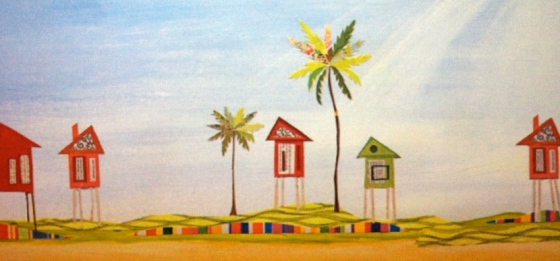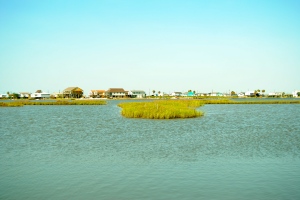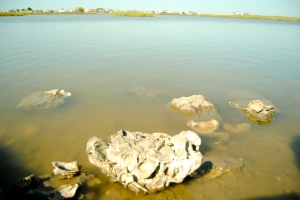Galveston, TX
July 1, 2013
This story is dedicated to Ann Graham, who devoted her life to teaching. She was a loving mother, wife, and friend. She was also gifted with an enviable green thumb.
“I just learned how to drive stick shift last month,” Kari Howard chuckled apologetically as she drove us around Galveston Bay, a little jerky in a big, standard transmission Ford truck. We were headed to a sand dune restoration site Howard helped with in the coastal town of Galveston, Texas.
Howard is a Habitat Stewardship Coordinator at Artist Boat, a local non-profit organization working to restore the area’s coastal habitats: wetlands, sand dunes, and prairies. But the 13 expert staff members at Artist Boat don’t just do coastal restoration—they teach it. All employees are either artists or scientists or dabble in both, and they incorporate creative art projects into their restoration education to help kids retain what they learn. So, while Howard learns to maneuver a clutch, she also helps K-12 students from underserved urban schools learn how coastal ecosystems work, what threatens them, and how to replant vegetation to boost habitat health and protect residents against storms.

At Galveston’s busiest public beach, along the town seawall, 1st and 2nd grade children painted educational mosaics about local sea life on public benches. Kari Howard sits on one such bench.
“Conservation is really important, but if we don’t teach younger generations about the ecosystem, there won’t be anyone to carry it on,” Howard told us.
Last year, students participated in an Artist Boat dune restoration in the Bermuda Beach subdivision. They planted dune grasses and other native species along four acres of beach to build up the sand dunes that protect homes from storm surge and provide new habitat for the endangered Kemp’s Ridley turtle and other species. Each day for eight days, between 25 and 50 kids in third to twelfth grade helped plant grasses. They threw balls of seed into the sand and planted two-inch seedlings of native species. Grants from the Texas Parks and Wildlife Department and the U.S. Fish and Wildlife Service paid for the school buses and supplies, so the Houston inner city schools only had to cover lunches—many of the students are on free lunch programs.
 “Some of the kids have never seen the coast before. Many of them don’t know much about marine ecosystems, and working on this project might be the only chance they get,” Howard explained.
“Some of the kids have never seen the coast before. Many of them don’t know much about marine ecosystems, and working on this project might be the only chance they get,” Howard explained.
When we visited the project site one year later, the dunes had grown six inches thanks to the grasses that now hold them together.
Recovery is a long boat ride
Teaching the next generation is a long-term investment, but there’s an urgency to Artist Boat’s mission and those of other groups doing similar restoration work in the area. The island, connected to mainland Texas by bridge, was hit hard by Category 2 Hurricane Ike in 2008. Businesses and homes flooded seven or eight feet. The city’s 10-mile seawall protected much of the inner city infrastructure, but many houses on the bayside of the barrier island were destroyed.
“Galveston is a funny little community. Some residents had never left the island in their lives, but they had to leave during Ike,” said Howard.
The damage is still felt, and recovery is ongoing. Some people didn’t return to their homes, including a number of ‘born-on-island’ residents. Downtown businesses have marked the ‘Ike line’ on their buildings as a reminder of just how bad the flooding was.
Retreat, and harden the future

The ‘Pleasure Pier’ amusement park was built after Hurricane Ike. It might be in trouble during the next hurricane.
Dr. Quenton Dokken, President and CEO of the Gulf of Mexico Foundation, an organization that helps protect coastal economies in all Gulf of Mexico states and four U.S. territories, thinks a gradual population shift back from the coastline is inevitable, especially in light of predicted climate impacts. A 2009 local assessment projected that climate change would lead to increased hurricane intensity as well as a relative increase in sea level of three feet (accounting for land subsidence) by 2100. Among other consequences, sea level rise means bigger storm surges when the hurricanes make landfall.
“People will eventually have to move inland. We’ll have no choice,” Dokken said.
He explained that hard structures like seawalls and levees will be necessary to adequately protect existing development. One proposed solution is the ‘Ike Dike,’ a 15- to 20-mile extension of the existing seawall around the bayside of the island, complete with two floodgates that could be closed during hurricanes. The project would attempt to armor Galveston against future 10,000-year storm threats, or storms so large that, statistically, they are projected to occur once in 10,000 years.
But Dokken doesn’t think the ‘Ike Dike’ is the answer. Aside from the negative impacts to delicate habitat in the area, the Ike Dike could encourage more development in dangerous coastal flood zones. The project might cost quadruple the estimated $4 to $6 billion, said Bob Stokes, President of the Galveston Bay Foundation, another group that works to preserve the Bay through education, advocacy, and conservation. Plus, even the existing seawall costs a lot to maintain, never mind an extra 20 miles.
Getting the grown-ups on board
But Dokken doesn’t think educating kids is enough either. “It’s a tremendous allaying tactic to push everything onto the next generation by only educating the kids. We need to educate adults too: City Council members, mayors, fishermen, oil and gas workers.”
To that end, the Gulf of Mexico Foundation is building a new Habitat Restoration Technology Training Center in Galveston for adults across the Gulf Coast to gain the necessary skills to do restoration work, like repairing oyster beds, wetlands, and sand dunes. The LEED-certified Center, expected to open in 2014, will replace an abandoned building that was damaged in Hurricane Ike and be built two feet above the city requirement to withstand expected storm impacts and sea level rise. The Gulf of Mexico Foundation will also protect adjacent wetlands to serve as training grounds.

The proposed restoration training center for the Gulf of Mexico foundation. Source: Gulf of Mexico Foundation
Some inroads are already being made among adults. Since the Galveston Bay Foundation began its restoration work, staff have worked with volunteers of all ages to restore 620 acres of marsh and seagrass, and several large-scale projects are on the horizon. The group has also worked closely with the shellfish industry. According to Courtney Smith, Vice President of Operations, the oyster industry
lost an estimated 60 percent of its consolidated oyster reefs. The Galveston Bay Foundation has been working with industry leaders to restore oyster beds since the storm. Though the industry has taken years to rebound, in 2010 Galveston Bay ranked second only to Louisiana for commercial harvest of Eastern oysters.
The organization has also begun incorporating climate projections into its project grant proposals. “We’re designing our projects a little beefier than before,” said Smith.
And all three organizations—Artist Boat, the Galveston Bay Foundation, and the Gulf of Mexico Foundation—are partnering with the oil and gas industry, involving local workers in volunteer days and educational trainings.

Sargassum seaweed keeps the sand from blowing away. Traditionally, the City bulldozed the sand to remove the seaweed. The City recently bought a $52,ooo ‘barber and rake’ machine that only scrapes the seaweed off the top and doesn’t disrupt the sand.
Reaction or action?
Though there is a lot of habitat restoration going on, Dokken and Smith agree that’s all it is—rebuilding after past destruction.
“We’re still just repairing what’s been broken,” said Smith.
Dokken points out that in order to get real action to protect Galveston Bay from bigger storms, “it’s probably going to take another hurricane.” The lack of proactive planning for climate change is, in part, due to the antithetical political attitudes toward climate change in the state.
For now, it’s through education efforts that these organizations are thinking longer term. At Artist Boat, to teach some third graders how dune vegetation helps keep beaches intact, Howard had them build sand castles near the waves. As the tide came in, the sand castles washed away. Then, she had the children rebuild their sandcastles, but this time with women’s pantyhose stretched in front, protecting the castles from the waves much like the roots of dune grasses act to hold sand in place.
“The kids got it right away,” Howard told us. “That’s important because we can conserve the planet as much as we can until we hit age 80, and then who’s going to do it?”






Pingback: To Restore the Coast, Galveston Gets Kids and G...
I love the emphasis on education in this piece, especially the effort to get grown-ups on board too. I also think the idea of pairing conservation organizations with oil and gas companies seems like a great outside-the-box approach to educating people in the area.
Pingback: Lessons Learned About Life in the ‘New Normal’ « Great American Adaptation Road Trip
Pingback: What drives communities to take action to adapt to climate change? « Great American Adaptation Road Trip